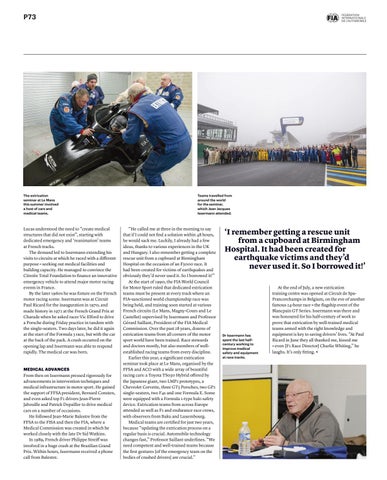P73
The extrication seminar at Le Mans this summer involved a host of cars and medical teams.
Lucas understood the need to “create medical structures that did not exist”, starting with dedicated emergency and ‘reanimation’ teams at French tracks. The demand led to Issermann extending his visits to circuits at which he raced with a different purpose – seeking out medical facilities and building capacity. He managed to convince the Citroën Total Foundation to finance an innovative emergency vehicle to attend major motor racing events in France. By the later 1960s he was fixture on the French motor racing scene. Issermann was at Circuit Paul Ricard for the inauguration in 1970, and made history in 1972 at the French Grand Prix at Charade when he asked racer Vic Elford to drive a Porsche during Friday practice in tandem with the single-seaters. Two days later, he did it again at the start of the Formula 3 race, but with the car at the back of the pack. A crash occurred on the opening lap and Issermann was able to respond rapidly. The medical car was born.
MEDICAL ADVANCES
From then on Issermann pressed rigorously for advancements in intervention techniques and medical infrastructure in motor sport. He gained the support of FFSA president, Bernard Consten, and even asked top F1 drivers Jean-Pierre Jabouille and Patrick Depailler to drive medical cars on a number of occasions. He followed Jean-Marie Balestre from the FFSA to the FISA and then the FIA, where a Medical Commission was created in which he worked closely with the late Dr Sid Watkins. In 1989, French driver Philippe Streiff was involved in a huge crash at the Brazilian Grand Prix. Within hours, Issermann received a phone call from Balestre.
Teams travelled from around the world for the seminar, which Jean Jacques Issermann attended.
“He called me at three in the morning to say that if I could not find a solution within 48 hours, he would sack me. Luckily, I already had a few ideas, thanks to various experiences in the UK and Hungary. I also remember getting a complete rescue unit from a cupboard at Birmingham Hospital on the occasion of an F3000 race. It had been created for victims of earthquakes and obviously they’d never used it. So I borrowed it!” At the start of 1990, the FIA World Council for Motor Sport ruled that dedicated extrication teams must be present at every track where an FIA-sanctioned world championship race was being held, and training soon started at various French circuits (Le Mans, Magny-Cours and Le Castellet) supervised by Issermann and Professor Gérard Saillant, President of the FIA Medical Commission. Over the past 28 years, dozens of extrication teams from all corners of the motor sport world have been trained. Race stewards and doctors mostly, but also members of wellestablished racing teams from every discipline. Earlier this year, a significant extrication seminar took place at Le Mans, organised by the FFSA and ACO with a wide array of beautiful racing cars: a Toyota TS030 Hybrid offered by the Japanese giant, two LMP2 prototypes, a Chevrolet Corvette, three GT3 Porsches, two GP2 single-seaters, two F4s and one Formula E. Some were equipped with a Formula 1-type halo safety device. Extrication teams from across Europe attended as well as F1 and endurance race crews, with observers from Baku and Luxembourg. Medical teams are certified for just two years, because “updating the extrication process on a regular basis is crucial. Automobile technology changes fast,” Professor Saillant underlines. “We need competent and well-trained teams because the first gestures [of the emergency team on the bodies of crashed drivers] are crucial.”
‘I remember getting a rescue unit from a cupboard at Birmingham Hospital. It had been created for earthquake victims and they’d never used it. So I borrowed it!’
Dr Issermann has spent the last halfcentury working to improve medical safety and equipment at race tracks.
At the end of July, a new extrication training centre was opened at Circuit de SpaFrancorchamps in Belgium, on the eve of another famous 24-hour race – the flagship event of the Blancpain GT Series. Issermann was there and was honoured for his half-century of work to prove that extrication by well-trained medical teams armed with the right knowledge and equipment is key to saving drivers’ lives. “At Paul Ricard in June they all thanked me, kissed me – even [F1 Race Director] Charlie Whiting,” he laughs. It’s only fitting.
